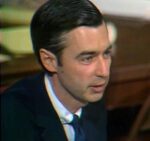If you were alive during the ‘80s and ‘90s, there’s likely a single name you associate with the word “science”. Carl Sagan was the most popular scientist of his era, a guy who could take complex, abstract concepts and make them understandable for millions. A trained astrophysicist who worked on some of NASA’s most famous missions, Sagan was also the man who turned a generation onto the wonders of our own solar system.
But while most of us probably know Sagan’s public persona, the one he assumed to present PBS’s classic 1980 series Cosmos, how much do we know about the man himself? Born into a working class Brooklyn neighborhood, Sagan worked hard to become the most eminent scientist in America. But he also courted controversy, pioneering ideas that made him as many enemies as he had adoring fans. Inspiring, insightful, egotistic, seductive, this is the life of Carl Sagan, the man who brought astronomy to the people.
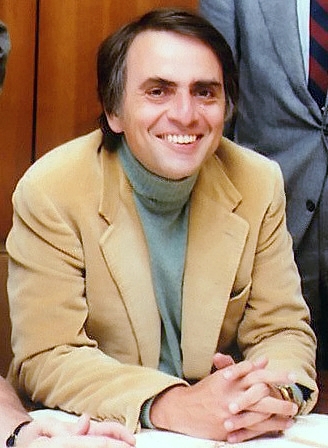
All the Lights in the Sky
On clear nights in Brooklyn, it’s still possible to just make out the stars despite the light pollution.
Tiny pinpricks of light faintly visible through New York City’s eternal orange glow, they act as comfort to some, a romantic backdrop for others.
For young Carl Sagan, gazing up at those same stars eighty years ago, they acted as something else entirely: a mystery.
Born Carl Edward Sagan on November 9, 1934 in Brooklyn, young Carl was a boy with plenty of time on his hands for thinking.
His father, Samuel, worked backbreaking hours in the garment industry, while his mother Rachel was strongly religious and very active in the local Reform Jewish community.
As a result, young Carl spent many hours left to his own devices, hours he spent trying to get answers to a seemingly simple question: what were these stars he could see?
Finding out the truth was harder than it sounded. According to Sagan, most of the adults he asked would reply with “they’re just lights in the sky.”
But the boy knew they had to be something more than that. They were lights, OK, but what lights? What were they made of? How did they get there?
The answer would change young Carl’s life.
Sent by his mother to New York Public Library aged either five or seven – the number changes depending on who is telling the story – the boy asked for a book on the stars. In an oft-told tale in later life, Sagan would recount how the librarian initially gave him a book on Clark Gable and Greta Garbo.
Eventually, though, the boy got his book on astronomy. Back in Brooklyn, he sat down to find the answer to his question.
“The sun,” the book said, “is a star but close up. The stars are suns, but far away.”
For you or I, raised on generations of science programs, that might sound like a well, duh moment. But for the young boy from Brooklyn, it was a revelation.
Those lights in the sky were other suns, each maybe circled by their own worlds, each maybe shining down on some alien city, where another boy looked at the heavens and wondered what those lights were.
In that moment, Carl’s conception of the universe expanded as suddenly as the universe itself after the Big Bang.
As Sagan would later remark, the universe now seemed a whole lot bigger than Brooklyn.
The discovery turned the boy into a veritable science fiction nut. He devoured the Martian novels of Edgar Rice Burroughs, began plotting to get himself abducted by aliens.
In 1945, when he heard of Hitler’s V2 rockets falling on England, the boy thought only of taking one of those rockets and riding it to another world.
Instead, his father took him to New Jersey.
In 1947, Samuel Sagan was making enough money to move his family out of New York and into a middle class neighborhood. By now, young Carl was 13 and obsessed with UFOs.
In fact, it’s easy to imagine this turning into the biography of a great science fiction writer. Carl made his first ever radio broadcast around this time, telling audiences of a local college station that aliens were visiting Earth.
Yet, it wouldn’t be fiction that supplied Carl an outlet for his feelings of awe about space.
In 1951, after graduating high school, Carl enrolled at the University of Chicago to study physics.
It was while there that Sagan came to the attention of Gerard Kuiper.
The man for whom the Kuiper Belt on the fringes of our solar system is named, Kuiper is known today as the father of planetary science.
And he was about to transform young Carl Sagan into his protégé.
Love and Rockets
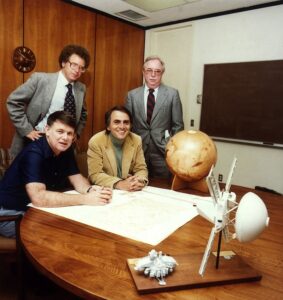 On October 5. 1957, a strange speck of light streaked through the skies above Earth.
On October 5. 1957, a strange speck of light streaked through the skies above Earth.
If any children out there looked up and asked their parents what that light was, they wouldn’t have gotten the answer Carl Sagan once had.
This wasn’t a star. It was Sputnik 1, the first manmade satellite ever put in space. And it was about to kick off the space race.
For Sagan, the flight of Sputnik 1 was the capstone to an eventful year.
That June, he’d married Lynn Alexander, and the two were already planning to start a family.
At the same time, his Ph.D. advisor, Gerard Kuiper, was getting Sagan extra work on a top secret US government project to detonate a nuclear bomb on the Moon.
You’ll be glad to hear that particular project never went ahead.
But Kuiper’s influence was still exerting a pull on the younger man. Like an object in the Kuiper Belt drawn inexorably in towards the Sun, Sagan was being pulled towards planetary science.
The planet that eventually captured him? Venus.
That’s not a clever metaphor for love. The actual planet Venus was the focus of Sagan’s thesis, in part because it was still such a mystery.
At the end of the 1950s, all scientists knew about Venus was that it was covered in clouds. Many still assumed rolling oceans, or maybe even humid jungles lay below the atmosphere.
Sagan blew those beliefs out the extraterrestrial water.
Under the supervision of Kuiper, he theorized that Venus was a Hellish planet with an atmosphere hot enough to melt lead. Not long after, he was proved right.
The thesis threw a spotlight on Sagan. Barely had he graduated in 1960 than he was snapped up by University of California, Berkley, to help build instruments for NASA’s Mariner 2 mission.
Two years later, he was poached to work at Harvard University and the Smithsonian Astrophysical Observatory.
It was while at Harvard that Sagan identified Mars’s epic, swirling dust storms.
It was also while at Harvard that Sagan got seriously into aliens.
For all his reputation may have grown, Sagan was at heart still a kid fantasizing about life on Mars.
As the sixties got underway, and free love and copious marijuana use blew through university corridors in a cloud of green smoke, Sagan began writing books on the existence of aliens.
He got involved with SETI, the Search for Extraterrestrial Intelligence. Known by another name at that point, it was the pet project of Frank Drake at Cornell University.
But there was another story that was much bigger for Sagan’s personal life: the breakdown of his marriage.
In 1962, Sagan divorced Lynn Alexander, and watched as she took the kids away. Four years later, on April 6, 1986, he married the artist Linda Salzman.
That same year, Sagan changed jobs yet again.
His fascination with aliens had made the planetary scientist something of an embarrassment to Harvard, so it was with mutual relief that Sagan applied for a job at Cornell, working alongside his new SETI buddy Frank Drake.
At the Laboratory for Planetary Studies, Sagan kept up his work with NASA, becoming part of the briefing team for the Apollo 11 crew.
A year later, he finally set out his views on aliens.
At a UFO symposium, the scientist argued that intelligent life in our galaxy was a very real possibility. But he also argued against the idea that aliens were visiting Earth in UFOs and probing farmers’ backsides.
It was an important distinction, one that distinguished Sagan from the Roswell-obsessed cranks.
It also summed up his philosophy neatly.
For Sagan, UFOs made no sense. They suggested Earth was special, that humans were the center of galactic attention, when rational thought suggested the opposite would be true.
Incidentally, it was around this time that Sagan started to get a reputation among his fellow scientists for being an egotist who cared more about publicity stunts than crunching data.
The next few years would do nothing to dispel this belief.
The Pioneers
By 1971, Sagan was a full professor at Cornell with a nice sideline in briefing reporters on complex scientific topics.
His natural charisma and ability to condense complicated ideas down to an easy to understand analogy had made him a darling of the serious press.
But if Sagan’s fellow scientists were already fed up with his celebrity, they were about to get even fed upper.
In 1971, NASA was deep in the final preparation stages for the Pioneer 10 and 11 probes.
The most ambitious space mission to date, the twin Pioneers were designed to become the first manmade objects to pass through the asteroid belt and investigate the outer planets.
But it was another detail about the Pioneers that captured the public attention.
After they completed their missions, they’d carry on out into interstellar space.
If aliens were monitoring our solar system’s fringes, Pioneer 10 would be the first manmade object they ever encountered.
Most serious scientists paid little attention to this aspect of Pioneer. But the idea captured Sagan’s imagination: If an alien civilization picked up the probe, what would they think?
Sagan’s big breakthrough was realizing we could tell them what to think.
Mere months before the Pioneers launched, Sagan contacted NASA. He told them he wanted to affix a plaque to each Pioneer in case aliens found them.
To his infinite surprise, NASA basically said “Yeah, sure. Why not?”
We need to pause here and drink in just how insane this really was. Launching a probe into the farthest reaches of the solar system is a science so precise that the tiniest change can throw all your calculations out of whack. And now some dude wants to affix a plaque on the damn thing?
Yet NASA authorized it. They put millions of dollars aside.
And so it was, in 1971, that Sagan, his wife Linda, and Frank Drake sat down to write a message to the universe.
Today, the Pioneer plaque is iconic. But even if you’ve seen it, you might not be aware of quite how detailed it is.
The basic idea was to show aliens who we are and where we come from. The first part was easy. The plaque has an engraving of a naked man and woman facing outwards.
The second part was much, much harder.
How do you demonstrate ideas of distance to a totally alien intelligence, one which has no conception of feet or meters or anything else?
Sagan hit upon the idea of using a hydrogen atom.
The most common element in the universe, hydrogen atoms can exist in different energy states. When they change states, they release a wave of electromagnetic radiation.
Sagan, Drake, and Linda turned this wave into a universal measurement.
The wavelength is around 21 centimeters, the length of time it lasts about .7 of a nanosecond.
Sagan’s team gave this measurement the binary value of 1. They then used it to describe everything from the average height of humans to the distance to Earth.
That image on the plaque’s right that looks like a bunch of lines exploding out a dot? That’s a map, showing the distance from our sun to various neutron stars. If an advanced civilization found it, they could potentially locate our Earth.
The plaque is a masterpiece of science and art joined hand in hand.
It’s also monumentally useless.
Although Pioneer 10 is aiming in the vague direction of another star, Aldebaran, the chances of either probe ever encountering intelligent life is so close to zero you might just as well write zero.
People in 1971 were all too aware of this. There was outrage that Sagan had blown millions of taxpayer dollars on a picture that would never even be seen.
Yet Sagan maintained it was the right thing to do.
He wasn’t building that plaque for aliens. He was building it for us, here on Earth. To show the public not just what humanity could do, but how big and wonderful the universe they lived in was.
On March 2, 1972, Pioneer 10 launched, followed shortly after by Pioneer 11. Today, both probes are still out there, carrying Sagan’s plaque towards the very edges of our solar system. Towards the final frontier.
Back on Earth, the Pioneer plaque made Sagan an international celebrity. But science’s personal publicist wasn’t done yet.
His greatest achievement was just around the corner.
A Never Ending Voyage
The next few years saw Sagan establish himself as the best known scientist in America.
He appeared on the Tonight Show with Johnny Carson, became the public face of NASA’s Viking project to land a probe on Mars.
He also had a not insignificant effect on the future of popular science. In 1975, a 17 year old Neil de Grasse Tyson nearly had a heart attack when he got a letter from Sagan telling him his Cornell application was inspiring and inviting him to come visit sometime.
But it was in 1977 that Sagan pulled off his greatest publicity stunt.
At the time, NASA was preparing to launch two Voyager probes towards Jupiter and Saturn, and then on into interstellar space.
Boyed by the PR Pioneer’s plaque had generated, the agency contacted Sagan with a much bigger proposal. They wanted to send a literal record of humanity into space, for aliens to find one day.
And they wanted Sagan to decide what would go on it.
Voyager’s golden record is today iconic. But in 1977, it was a head-scratching challenge.
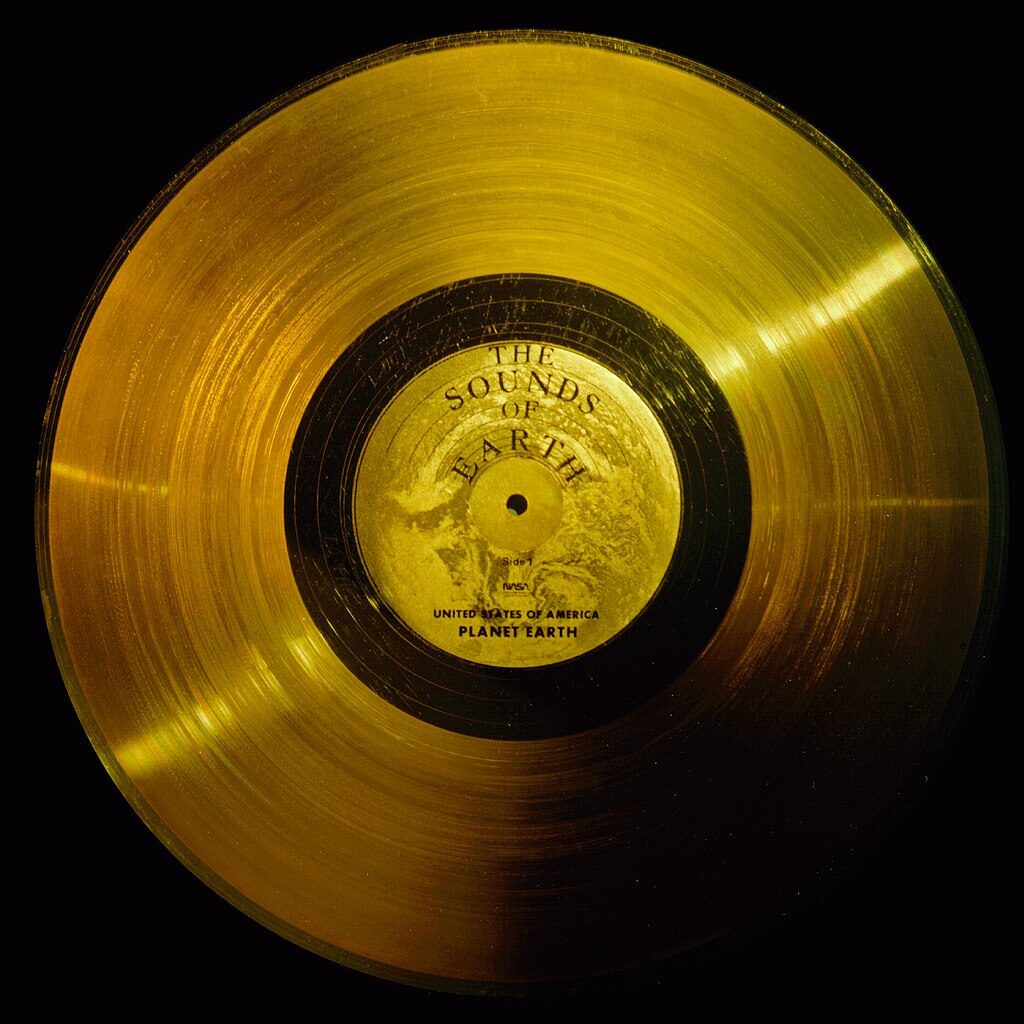
Pressing a record and encoding it with instructions would be hard enough, but the real challenge would be choosing what to put on it.
To represent humanity, Sagan assembled a team consisting of himself, his wife Linda, Frank Drake, the artist Jon Lomberg, and Timothy Ferris, a contributing editor to Rolling Stone.
He also invited onboard the writer Ann Druyan. More on her in a moment.
For the next few months, the team worked at a fever pitch, trying to cram as much information on the record as possible.
Famously, this included samples of a human heartbeat, greetings read out in 55 different languages, whale songs, and the whole of Chuck Berry’s Johnny Be Goode.
It also included a handful of analog pictures.
There were some obvious ones, such as the Taj Mahal and the Golden Gate Bridge, the sort of pictures you’d include if you were sending up a Lonely Planet guide to humanity.
But there were more scientific ones, too. DNA structures, images explaining human processes of eating and drinking, athletes performing exercises.
But the most interesting was a scan of the author Ann Druyan’s brainwaves.
During the recording process, the team reasoned that a super advanced alien society could probably take those brainwaves and decode them. So Druyan was given strict instructions to think about certain common objects, and then had her brain scanned for an hour.
It was only much, much later, after Voyager 1 and 2 were well on their way out of the solar system, that Druyan admitted she hadn’t done as she was told.
On June 1, 1977, just before her brainwaves were monitored, she and Sagan had started an affair. Her recording was full of thoughts of the man she’d just fallen for.
That’s right. The farthest manmade object in human history is in part a secret love letter to the man behind it all.
Voyager 2 launched on August 20, 1977. Voyager 1 followed on September 5. Sagan described them eloquently as “a message in a bottle cast into the cosmic sea.”
35 years later, in 2012, Voyager 1 became the first manmade object to ever enter interstellar space. Although Voyager 2 has since joined it (in November 2018), it remains the farthest manmade object from Earth. Unless we discover warp drive, it’s a record that probably won’t be beaten.
Not long after the probes went up, Sagan and Druyan started looking for a reason to carry on working together. That same year, they hit on the prefect idea.
They would write a TV show about science. One that condensed the whole, amazing history of human achievement into 13 hour long, thought-provoking episodes.
The name of that show? Cosmos.

Into the Cosmos
For millions of people, their defining image of Carl Sagan will forever be the scientist standing on the edges of a low cliff before a pounding sea, describing the impossible extent of our universe.
The first episode of Cosmos aired on September 28, 1980, three years after Sagan and Druyan first sat down to start writing.
They had not been easy years.
There was Sagan’s ongoing, very acrimonious divorce from Linda Salzman, for one thing.
For another, there was the way, in 1979, that Sagan’s father, Samuel, came down with cancer.
The onset was so swift, so shocking, that Samuel and Rachel were forced to move in with Sagan and Druyan.
For months, Sagan had watched his father dying, unable to tear himself away from his work on Cosmos and at Cornell long enough to give his old man the goodbye he deserved.
When Samuel finally passed away, in October, 1979, Sagan was devastated.
Yet life must go on. And, for Carl Sagan, that meant finishing Cosmos for PBS.
American public television has simply never created anything as popular since. It’s estimated half a billion people watched Cosmos globally on transmission.
What’s striking today is how captivating it remains. While the retro 80s graphics are amusing in hindsight, Sagan’s earnestness still shines through. His feeling of wonder is still enough to make you want to quit the YouTube channel you work at and dedicate your life to science.
Not that it’s a perfect show, by any stretch. The endless shots of Sagan pulling up dandelions and gasping in awe at some computer graphic are almost enough to make you wet yourself trying not to laugh.
There’s actually a story that Sagan only intended to use two or three of those shots, but he managed to annoy one of the producers so much that the guy stuck them into every episode to try and make Sagan look as silly as possible.
Unintentionally hilarious cutaways aside, Cosmos still managed to turn Sagan into a household name.
Had he ended his career at that point, in fact, he probably would be remembered warmly by just about everyone.
But Sagan didn’t stop there. Instead, he followed up Cosmos by getting seriously into activism.
The turning point came in 1983. Two years before, Sagan had finished divorcing Linda and married Ann Druyan, and now he was settling down to life with the woman of his dreams.
It was a life that was very nearly snatched away from him.
That year, Sagan went into hospital for a routine appendectomy and nearly died. He came so close to bleeding out that only ten hour emergency surgery saved his life.
When Sagan recovered, he seemed changed by the experience. Now he no longer wanted to merely educate people about the world.
He wanted to shape it for the better.
He began while he was still in the ICU, organizing a mass protest against Ronald Regan’s new Star Wars missile defense system, a protest that made him unpopular among Republicans.
Not that Sagan cared. Horrified by US nuclear brinkmanship with the Soviet Union, he attempted to win over the public to his cause.
In 1983, Sagan co-authored the paper that introduced the concept of nuclear winter: the idea that even a limited nuclear exchange would cool the climate so drastically that famine would wipe out most of humanity.
Around the same time, Sagan began campaigning against global warming, calling it a threat to mankind and demanding an international solution.
It was typical Sagan, focusing on the big picture to the detriment of all else.
In 1986, he even managed to get himself arrested at an anti-nuclear event in Nevada, trespassing on government property in an attempt to halt underground testing.
Still, this was a minor brush with the law at best. Controversial or not, Sagan was still beloved by millions. He was only 52. He had decades left to win people to his side.
Didn’t he?
A Pale Blue Dot
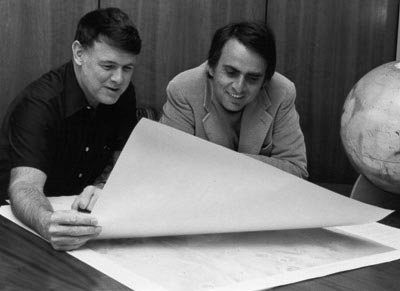
On February 14, 1990, Voyager 1 turned its camera towards Earth for the final time.
From unimaginable millions upon millions of miles away, the probe snapped a photo of our planet, suspended in a sunbeam.
The picture was the work of Carl Sagan, who’d convinced NASA to turn Voyager 1 around for this one moment.
When the image finally arrived back on Earth, it changed our conception of our planet.
You’ve almost certainly seen the Pale Blue Dot photo before, almost certainly felt that sense of awe, seeing everything you’ve ever known reduced to a tiny speck in an infinity of space.
But Sagan wasn’t content to simply be the driving force behind the image. He wanted the picture to make a statement mankind could carry through the ages.
It’s a statement worth quoting at length:
“Look again at that dot. That’s here. That’s home. That’s us. On it everyone you love, everyone you know, everyone you ever heard of, every human being who ever was, lived out their lives. The aggregate of our joy and suffering, thousands of confident religions, ideologies, and economic doctrines, every hunter and forager, every hero and coward, every creator and destroyer of civilization, every king and peasant, every young couple in love, every mother and father, hopeful child, inventor and explorer, every teacher of morals, every corrupt politician, every “superstar,” every “supreme leader,” every saint and sinner in the history of our species lived there–on a mote of dust suspended in a sunbeam…
It has been said that astronomy is a humbling and character-building experience. There is perhaps no better demonstration of the folly of human conceits than this distant image of our tiny world. To me, it underscores our responsibility to deal more kindly with one another, and to preserve and cherish the pale blue dot, the only home we’ve ever known.”
If there’s ever been a more perfect summing up of the vastness of the cosmos or mankind’s position within it, we’ve yet to hear it.
For the consummate publicist Sagan, writing this speech was just another act in a career that had already come to define how we think about space.
He had no way of knowing it would be his last, great moment.
The warning signs came subtly. In 1994, Ann noticed a bruise on Sagan’s arm that wouldn’t fade.
After at first dismissing it, Sagan finally went to the hospital for a blood test. A few days later, the doctor called up, sounding deeply apologetic.
They’d messed up the samples, the doctor said. Sagan would have to come in for another test.
When Ann asked why, the doctor replied. There was no way this could be Sagan’s blood. Whoever’s it was, they would be dead within months.
But, of course, there had been no mistake.
Sagan was diagnosed with myelodysplasia, a type of cancer, and given six months to live. Although his sister managed to buy him some time with an extremely painful bone marrow transplant, it could only delay the inevitable.
On December 20, 1996, after two grueling, painful years, Carl Sagan died at the age of 62. The astronomer of the people was no more.
For a generation, Carl Sagan came to define how they thought about the universe. He handed them the tools to make sense of the vast and empty cosmos around them, and in doing so brought a sense of hope, of wonder, to us all.
Yet his story may not be over.
In around 296,000 years, Voyager 2 is expected to pass the great sun of Sirius, in the constellation Canis Major.
There, it’s possible it could be intercepted by an alien civilization. A civilization that might just have the power to decipher the golden record it is carrying, to access it’s data and decode Ann Druyan’s recorded brainwaves.
If they did that, then they’d find the image of the man who’d made that record, the faintest analog memory of the astronomer who, impossible eons ago, had captured Druyan’s heart.
The chances of this scenario coming to pass are infinitesimally small, verging on the utterly impossible.
But the chance is still there. For Carl Sagan, the boy who once looked at the stars above Brooklyn and dreamed of being abducted by aliens, the thought his image could live on like that – no matter how improbable – might have been enough.
(Ends).
Sources:
Podcast: https://www.bbc.co.uk/programmes/b00scvqk
Biography channel bio: https://www.youtube.com/watch?v=NqYNR1Qx5-M
https://www.britannica.com/biography/Carl-Sagan
https://news.nationalgeographic.com/news/2014/03/140316-carl-sagan-science-galaxies-space/
https://www.thoughtco.com/carl-sagan-biography-4165917
Pioneer plaque: http://www.planetary.org/blogs/guest-blogs/2016/0120-the-pioneer-plaque-science-as-a-universal-language.html
Voyager golden record: https://voyager.jpl.nasa.gov/golden-record/
https://www.smithsonianmag.com/science-nature/what-is-on-voyagers-golden-record-73063839/
Pale Blue Dot picture: https://www.nasa.gov/jpl/voyager/pale-blue-dot-images-turn-25
Project A119: https://io9.gizmodo.com/what-exactly-was-carl-sagan-working-on-with-the-u-s-mi-5968239



